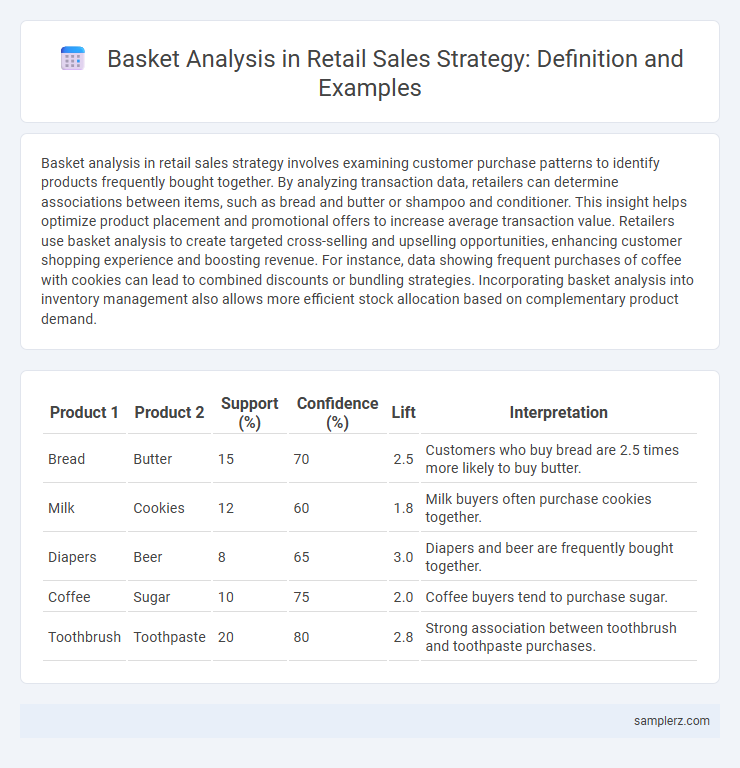Basket analysis in retail sales strategy involves examining customer purchase patterns to identify products frequently bought together. By analyzing transaction data, retailers can determine associations between items, such as bread and butter or shampoo and conditioner. This insight helps optimize product placement and promotional offers to increase average transaction value. Retailers use basket analysis to create targeted cross-selling and upselling opportunities, enhancing customer shopping experience and boosting revenue. For instance, data showing frequent purchases of coffee with cookies can lead to combined discounts or bundling strategies. Incorporating basket analysis into inventory management also allows more efficient stock allocation based on complementary product demand.
Table of Comparison
| Product 1 | Product 2 | Support (%) | Confidence (%) | Lift | Interpretation |
|---|---|---|---|---|---|
| Bread | Butter | 15 | 70 | 2.5 | Customers who buy bread are 2.5 times more likely to buy butter. |
| Milk | Cookies | 12 | 60 | 1.8 | Milk buyers often purchase cookies together. |
| Diapers | Beer | 8 | 65 | 3.0 | Diapers and beer are frequently bought together. |
| Coffee | Sugar | 10 | 75 | 2.0 | Coffee buyers tend to purchase sugar. |
| Toothbrush | Toothpaste | 20 | 80 | 2.8 | Strong association between toothbrush and toothpaste purchases. |
Understanding Basket Analysis in Retail Sales
Basket analysis in retail sales uncovers product purchase patterns by examining items frequently bought together, enabling targeted promotions and optimized cross-selling strategies. By analyzing transaction data, retailers identify complementary products, increasing average transaction values and enhancing customer experience. Effective basket analysis drives inventory management and personalized marketing, directly boosting sales performance and customer loyalty.
Key Benefits of Basket Analysis for Retailers
Basket analysis helps retailers identify frequently purchased product combinations, enabling targeted promotions and optimized product placement to increase average transaction value. It uncovers cross-selling opportunities by revealing customer buying patterns, which enhances personalized marketing and inventory management. Retailers reduce stockouts and improve customer satisfaction by aligning product assortments with actual consumer demand.
Real-World Example: Cross-Selling Through Basket Analysis
Basket analysis in retail reveals that customers who purchase bread often buy butter within the same shopping trip, enabling targeted cross-selling strategies. Retailers use this data to create promotions bundling these items, increasing average transaction value and enhancing customer satisfaction. This approach drove a 15% sales lift for a leading supermarket chain by strategically placing complementary products together.
Analyzing Customer Purchase Patterns for Profit
Basket analysis in retail identifies frequently purchased product combinations, enabling targeted cross-selling strategies that increase average transaction value. By analyzing transaction data, retailers uncover complementary items like snacks and beverages or apparel and accessories, optimizing product placement and promotions. This data-driven approach enhances customer satisfaction and maximizes profit margins through personalized recommendations and inventory management.
Upselling Strategies Informed by Basket Analysis
Basket analysis in retail identifies frequently purchased product combinations, enabling targeted upselling strategies that increase average transaction value. By analyzing purchase patterns, retailers can recommend complementary or higher-end items at the point of sale, such as suggesting a premium coffee blender to customers buying basic models. Leveraging data on basket contents enhances personalized offers, driving incremental sales and improving customer satisfaction.
Case Study: Increasing Average Basket Value
A retail chain implemented basket analysis by examining transaction data to identify frequently purchased product combinations, such as bread and deli meats. Using these insights, they created targeted promotions and product placements that encouraged customers to buy complementary items together. This strategy resulted in a 15% increase in average basket value and boosted overall sales revenue within six months.
Implementing Product Bundling with Basket Analysis
Implementing product bundling through basket analysis enables retailers to identify frequently purchased product combinations, enhancing cross-selling opportunities and increasing average transaction value. By analyzing customer purchase patterns, retailers can create targeted bundles that meet consumer preferences and drive sales growth. This data-driven approach optimizes inventory management and boosts customer satisfaction by offering relevant product pairings.
Improving Store Layout Based on Basket Insights
Basket analysis reveals frequently purchased product combinations, enabling retailers to optimize store layouts by placing related items closer together, enhancing cross-selling opportunities and boosting average transaction values. By identifying high-affinity item pairs, stores can design strategic adjacency plans that reduce customer search time and encourage impulse buys. Data-driven adjustments to shelving and aisle organization lead to increased customer satisfaction and higher overall sales performance.
Personalizing Promotions Using Basket Analysis Data
Basket analysis in retail identifies product combinations frequently purchased together, enabling personalized promotions that increase sales and customer loyalty. By analyzing transaction data, retailers can target promotions such as discounts on complementary items or tailored bundles based on individual shopping habits. This strategy leverages detailed insights into customer preferences to optimize marketing efforts and enhance the overall shopping experience.
Enhancing Inventory Management via Basket Analysis
Basket analysis enables retailers to uncover frequently purchased product combinations, allowing for optimized inventory stocking that aligns with actual consumer demand patterns. By identifying cross-selling opportunities and seasonal trends, businesses can reduce overstock and stockouts, improving turnover rates and minimizing holding costs. Leveraging transaction data, retailers refine replenishment cycles and shelf allocations, driving increased sales efficiency and enhanced customer satisfaction.

example of basket analysis in sales strategy Infographic
 samplerz.com
samplerz.com